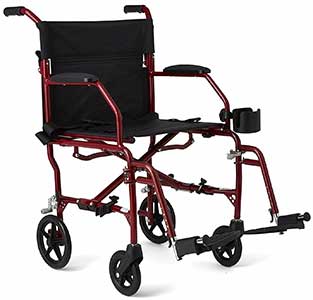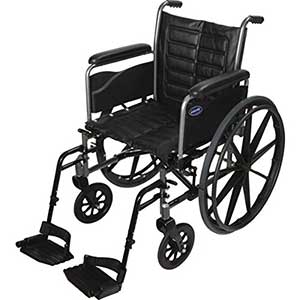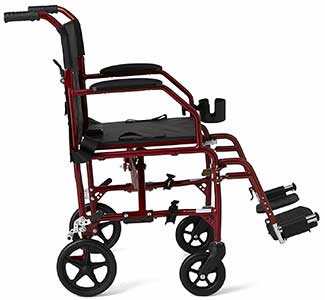
What Is the Difference Between a Transport Chair and Wheelchair?
A transport wheelchair is a light duty mobility device specifically designed to be pushed from behind.
On the other hand, a wheelchair can either be pushed from behind or propelled forward by the person sitting in the chair—thanks to the wheelchair’s large back wheels, which can be reached by a person sitting in the seat.
The Major Differences Between A Wheelchair and Transport Chair
The short answer above is fine as far as it goes, but there are some other important differences between transport and wheelchairs, which we’ll get into in the sections that follow. Let’s start by offering a more in-depth answer to the question “what is a transport wheelchair?”
Transport chairs were designed with two things in mind. First, as the name implies, ease of transport. That means that they tend to be smaller and lighter than standard wheelchairs. They offer a smaller folded footprint that can be more easily fit into the trunks of full-sized sedans or other vehicles, and are easier to maneuver, owing to their relatively lighter weight.
Don’t let their lighter weight fool you though. You can find just as many different transport wheelchair sizes as you can standard wheelchairs, including things like bariatric and pediatric transport chairs.


The other differences can best be identified by looking at the transport wheelchair vs. standard wheelchair side by side, which we’ll do next.
Standard Wheelchair vs. Transport Chair
Wheel Size Differences

The transport chair can easily be distinguished from the standard wheelchair by glancing at the rear wheels of both. Transport chairs have small rear wheels that are impossible to reach by the person sitting in the chair (and in fact, in general, the front and rear wheels of a transport chair tend to be the same size). That matters because gripping the rear wheels on a standard wheelchair is the means by which the person sitting in it propels the chair forward. Standard wheelchairs can be differentiated at a glance then, courtesy of their oversized rear wheels.
Braking Differences
Another significant difference lies in the fact that some (but by no means all) transport chairs have brakes on the handles on the back of the chair, enabling the person pushing it to apply the brakes more easily. In general, chairs with handbrakes like these are better able to navigate steep slopes and a wider variety of outdoor terrains, which is a topic we’ll cover in brief next.
Handling Differences

In general, transport chairs, with their smaller wheels are less able to navigate rough, outdoor terrains than a robust standard wheelchair designed with outdoor use in mind. Having said that, the presence of handbrakes on some models does mean that they are reasonably well suited to navigating slopes, provided the surface is relatively flat (pavement or very hard packed earth).
Comfort Level
Neither wheelchairs nor transport chairs were designed with comfort foremost in mind, but of the two, wheelchairs tend to be more comfortable, and thus, better suited to longer-duration sitting. Transport chairs are fine for short trips of 1-3 hours in duration. But much beyond that, it’s going to get uncomfortable, whereas a top of the line wheelchair with extra padding and a recline function could provide a surprising level of comfort, even if the person using it were in it for most of the day.
Adjustability
In general, wheelchairs offer more when it comes to fine-tuning adjustments than transport chairs, allowing the sitter to customize the chair for a better fit and overall level of comfort. There is some overlap here. You can find deluxe transport chairs that offer relatively more adjustment options than bargain-priced standard wheelchairs, but if you look at the broad spectrum of both types of products, the above holds true far more often than not.
Transformations

A small minority of transport chairs are designed in such a way that you can, by making a few adjustments, transform them into rollators, which are essentially “wheeled walkers.” We have never found a standard wheelchair engineered in this way.
Having said that, a small number of standard wheelchairs have interchangeable rear wheels, allowing them to be turned into transport chairs in a matter of minutes.
Here’s a summary of the information above, presented in table format:
| Chair Characteristic | Transport Chair | Standard Wheelchair |
|---|---|---|
| Smaller Footprint/Easier To Transport | ✘ | |
| Large Rear Wheels | ✘ | |
| Some Models with Handbrakes on the Back of the Chair | ✘ | |
| Relatively More Adjustment Options | ✘ | |
| Relatively More Comfortable | ✘ | |
| Generally Better Able to Handle a Wide Variety of Outdoor Terrains | ✘ | |
| Can Be Propelled by Either the Person Sitting in the Chair or Someone Pushing | ✘ | |
| Can Only Be Propelled by Someone Pushing the Chair | ✘ | |
| Ideally Suited for Short Duration Sitting (1-3 Hours) | ✘ | |
| Better Suited for Longer Duration Sitting | ✘ |
Wheelchair and Transport Chair Conclusion
As you can see then, there are actually a surprising number of differences between a wheelchair and a transport chair. In terms of which one is “right” for you, it’s not really a question of either a transport chair or wheelchair, unless your needs are very short term. In our view, here are the most likely use cases, and the corresponding optimal choices:
| Use Case | Optimal Choice (Wheelchair or Transport Chair) |
|---|---|
| You suffer a temporary, relatively short-term injury, and have an assistant who can help you get around | Transport chair |
| You suffer a temporary, relatively short-term injury, but no assistant is available | Wheelchair |
| You have a long-term mobility issue | Both. You’ll want a transport chair for short trips away from home, and a wheelchair for day-to-day use and longer-duration sitting |
If you have a need for a transport chair, a wheelchair, or both, be sure to check out our wheelchair and transport chair reviews elsewhere on this site. We’ve identified the best of the best in both categories, so whatever your needs are, we can help you zero in on the chair that’s right for you!